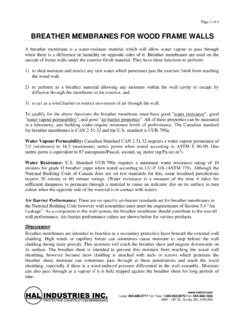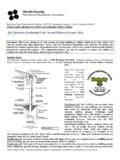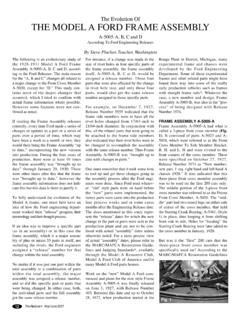Transcription of The Frame Jig
1 The Frame Jig Many potential Frame builders have the mistaken idea that the Frame jig must be extremely accurate, built like a precision timepiece and yet possess immense strength for bending and holding the tubing sections in position for welding but in fact the base structure of the jig, sometimes called the backbone, bed, table, base table, face table or Frame face can be almost any relative rigid structure. As long as the Frame bed or backbone is level in all directions the real precision and accuracy will come about through the fabrication of the fixtures that attach to this substructure or backbone and then will be adjusted and secured to position and hold the tubing and parts in place during the fabrication of the Frame or chassis. Figure 1 illustrates a typical jig assembly with the bed or backbone being made of two segments of box tubing with the various fixtures bolted into position.
2 Figure Error! Bookmark not defined. This type of Frame jig is referred to as being a bottom-up arrangement and while it has some disadvantages it is by far the most common type of jig used in custom motorcycle Frame construction. The following pictures illustrate a wide variety of Frame jigs ranging from simple and crude homemade units to extremely complicated fully adjustable units manufactured for large chassis shops. Though the range of sophistication is wide, all of the pictured jigs can produce very accurately aligned tube frames. In fact the precision of the final product is more dependent on the builders skill than the Frame jig being used and there are several custom Frame builders who don t use a Frame jig to begin with. In figure 2 we see a typical jig backbone, this example is made from channel and raised to knee height on cinder blocks.
3 Figure Error! Bookmark not defined. Another relatively simple layout below in figure 3 shows two longitudinal rails forming the backbone or bed framework. Figure Error! Bookmark not defined. Another typical horizontal rail or bed type of jig is shown in figure 4. Note that in this example, built to fabricate one specific type of Frame , the fixtures are not adjustable but are welded into position on the jig bed rail made from 3x3 square tubing. Figure Error! Bookmark not defined. Figure 5 depicts a true building table, often referred to as a face table. Note the leveling legs at each corner. Figure Error! Bookmark not defined. Figure 6 shows a typical jig fixture, this one used to position motor mounts. Figure Error! Bookmark not defined.
4 The same table as above but with the fixtures added is shown below. Figure Error! Bookmark not defined. All of the jigs we ve seen so far start with a foundation of a rail, multiple rails or table and build upward with the jig fixtures supported from below. An alternative to this scheme is the vertical jig, which is most often used in bicycle construction, but is occasionally seen in motorcycle fabrication shops especially where very lightweight racing frames are being built. Figure Error! Bookmark not defined. Figure 8 illustrates a Bringheli jig. Note the gauge rods with pointed ends used to calibrate the fixture clamps, an alignment method that can be adopted on any type of jig. Figure Error! Bookmark not defined. Figure 9 illustrates a Henry James vertical jig.
5 This structure is often called a modified plate jig or vertical plate jig since the bed is basically just a large flat piece of aluminum. Figure Error! Bookmark not defined. Figure 10 illustrates a motorcycle jig using both a building backbone or bed rail and a vertical panel made from spaced steel members. Figure Error! Bookmark not defined. Figure 11 is another combination jig exhibiting both horizontal and vertical primary support members. Jigs having vertical structural members or plates are superior to horizontal or backbone based jigs in that the fixtures that clamp the individual Frame components are shorter, located closer to the joints and connections, hence stiffer than the same type of clamping fixture that has to extend all the up from the base plate.
6 For this reason it is becoming more common to see at least some aspects of the vertical plate design incorporated into conventional rail or bed type building jigs. Another very popular fabrication technique used to improve the accuracy, rigidity and efficiency of Frame jigs is to incorporate as many pieces of the motorcycle as possible into the basic construction of the jig fixtures themselves. For example it is very common to actually build the jig around the engine, transmission, forks and wheels that will be used in the completed bike. Figure 12 illustrates a typical backbone type jig with major mechanical components included into the initial jig design. Figure Error! Bookmark not defined. This type of jig design will produce the best custom Frame designs since the potential rider can better visualize the final product and adjustment can be made with the rider sitting in place over the motor.
7 Needless to say accuracy will be superior because all of the component mounting points are located by the components themselves. In our shop we use a building jig that includes the bikes wheels, axles, transmission, motor cases and front forks for custom work and then if we decide to build more frames along the same lines we build a much smaller jig just to hold the chassis tubing. Jigs can be extremely simple as seen below in the example used by Michael Moore Figure Error! Bookmark not defined. Or unusually complicated is seen in this unit used by the Harris brothers shown in figure 14 or the multipurpose building and alignment model shown in figure 15. Figure Error! Bookmark not defined. Figure Error! Bookmark not defined. The jig shown in figure 16 is a good example of a well though out arrangement for a specific type of cycle.
8 Note that the rear axle adjusters are used to locate the wishbones and that the fixtures are mounted to pieces of channel iron that can be slid fore and aft along what looks like s 3x3 tube rail. Figure 16 There are almost as many jig designs as there are Frame makers since each jig is usually the work of the artist building the Frame . Some jigs are used over and over again producing several if not hundreds of so-called custom frames by Frame manufacturers while other jigs are only used once for a one-off bike. Sometimes a company or individual will sell a jig to another builder but without the actual plans or blueprints for the Frame that the jig was built for it is almost impossible to reconstruct the frames produced by the jigs original owner. This is a hard fact for many people to believe but the sole purpose of the Frame jig is to hold various bits and pieces of tubing in certain alignments and positions while they are tack welded together.
9 The jig itself will not give you a clue as to the lengths of tubing or angles for the various bends. As mentioned at the beginning of this section a welding jig doesn t necessarily have to be massively built because the jig and fixtures should only be used to position and lightly clamp together the Frame tubing for welding. If it becomes necessary to force a tube or fitting into position in the jig then something is wrong with your bender, your measurements or your design. Wherever possible I set up my jigs so that the Frame tubes simply lay into angle iron guides so that no clamps are needed in the first place and in fact even if you do clamp down all the tubing tightly, the Frame will distort anyway when it is taken out after final welding. Quite often, especially if you re making several frames that are similar but with minor customizations it is helpful to build separate jigs for separate parts of the Frame in addition to the assembly-welding jig.
10 In our shop for instance we use a jig to build up the upper rear tubes and another for the backbone and seat post before these sections are added to the main welding jig. For true custom bikes it is very likely that you ll wind up designing and building the Frame and the Frame -welding jig all at the same time developing individual elements and components of both the Frame and jig in sequence. For example you sketch out the backbone curve full scale on the shop floor, build a large-radius bending jig to shape the tube and then weld up a jig fixture to hold the backbone in position over the seat post with both tubes held in alignment with the steering head fixture. In addition to building and welding jigs it is often very helpful to build full-scale mockups of Frame components or in fact complete frames from wood dowels before you commit a design to steel tube.










